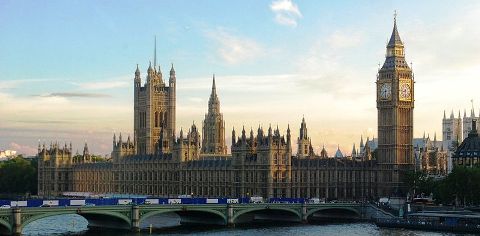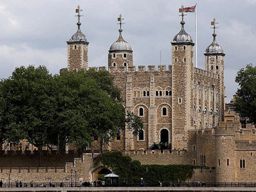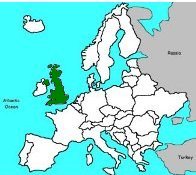Geography >> Europe >> United Kingdom History and Timeline
United Kingdom
Capital: London
Population: 67,530,172
Geography of United Kingdom
Borders: Republic of Ireland (only land border), Atlantic Ocean, North Sea, English Channel, maritime (water) borders with France, the Netherlands, Belgium, Denmark, Norway, Iceland, and Spain
Total Size: 244,820 square km
Size Comparison: slightly smaller than Oregon
Geographical Coordinates: 54 00 N, 2 00 W
World Region or Continent: Europe
General Terrain: mostly rugged hills and low mountains; level to rolling plains in east and southeast
Geographical Low Point: The Fens -4 m
Geographical High Point: Ben Nevis 1,343 m
Climate: temperate; moderated by prevailing southwest winds over the North Atlantic Current; more than one-half of the days are overcast
Major Cities: LONDON (capital) 8.9 million; Birmingham 2.9 million; Manchester 2.8 million; Leeds 2.3 million; Glasgow 1.8 million (Source: Statista Urban area population 2020)
Major Landforms: Island of Great Britain, Island of Ireland (northern fifth), Cumbrian Mountains, Pennines, Hebrides Islands, Shetland Islands, Scottish Highlands, Ben Nevis, Highland Boundary Fault, Mourne Mountains
Major Bodies of Water: Thames River, Severn River, Humber River, Lough Neagh (lake), Loch Lomond, Windermere, Bala Lake, English Channel, North Sea, Irish Sea, Celtic Sea, Atlantic Ocean
Famous Places: Tower of London, Buckingham Palace, Stonehenge, Westminster Palace, London Eye, Windsor Castle, Trafalgar Square, Cotswolds, St. Paul's Cathedral, Tower Bridge, Hyde Park, Loch Ness, Wembley Stadium, Ben Nevis, Globe Theatre, Edinburgh Castle, White Cliffs of Dover, Channel Tunnel

Palace of Westminster
Economy of United Kingdom
Major Industries: machine tools, electric power equipment, automation equipment, railroad equipment, shipbuilding, aircraft, motor vehicles and parts, electronics and communications equipment, metals, chemicals, coal, petroleum, paper and paper products, food processing, textiles, clothing, other consumer goods
Agricultural Products: cereals, oilseed, potatoes, vegetables; cattle, sheep, poultry; fish
Natural Resources: coal, petroleum, natural gas, iron ore, lead, zinc, gold, tin, limestone, salt, clay, chalk, gypsum, potash, silica sand, slate, arable land
Major Exports: manufactured goods, fuels, chemicals; food, beverages, tobacco
Major Imports: manufactured goods, machinery, fuels; foodstuffs
Currency: British pound (GBP)
National GDP: $2,288,000,000,000
Government of United Kingdom
Type of Government: constitutional monarchy
Independence: England has existed as a unified entity since the 10th century; the union between England and Wales, begun in 1284 with the Statute of Rhuddlan, was not formalized until 1536 with an Act of Union; in another Act of Union in 1707, England and Scotland agreed to permanently join as Great Britain; the legislative union of Great Britain and Ireland was implemented in 1801, with the adoption of the name the United Kingdom of Great Britain and Ireland; the Anglo-Irish treaty of 1921 formalized a partition of Ireland; six northern Irish counties remained part of the United Kingdom as Northern Ireland and the current name of the country, the United Kingdom of Great Britain and Northern Ireland, was adopted in 1927.
Divisions: The United Kingdom consists of four countries: England, Scotland, Wales, and Northern Ireland.
Each country has its own way of forming administrative divisions of the government. England is divided up into nine regions, Scotland into 32 council areas, Wales into 22 authorities, and Northern Ireland into 26 districts.

Tower of London
- North East
- North West
- Yorkshire and the Humber
- East Midlands
- West Midlands
- East of England
- London
- South East
- South West
National Anthem or Song: God Save the Queen
National Symbols:
- Animal - Bulldog (England), Lion
- Bird - Red Kite (Wales)
- Flower - Tudor Rose (England), Thistle (Scotland), Flax Flower (Northern Ireland)
- Tree - Royal Oak
- Colors - Red, white, and blue
- Motto - "God and my Right", "In Defense" (Scotland)
- Other symbols - Unicorn (Scotland), Welsh Dragon (Wales), Britannia
Description of flag: The flag of the United Kingdom was adopted on January 1, 1801. The name of the flag is the Union Jack. It has a blue background (field) with a red cross outlined in white and a red "x" outlined in white.
Other flags:
- England - White with a red cross.
- Scotland - Blue with a white "x".
- Wales - Two horizontal stripes of white (top) and green (bottom) with a red dragon.

Flag of Scotland
Other Holidays: New Years' Day (January 1), Saint Patrick's Day (March 17), Easter, May Day (May 1), Bank Holiday, Christmas (December 25), Boxing Day (December 26)
The People of United Kingdom
Languages Spoken: English, Welsh (about 26% of the population of Wales), Scottish form of Gaelic (about 60,000 in Scotland)
Nationality: Briton(s), British (collective plural)
Religions: Christian (Anglican, Roman Catholic, Presbyterian, Methodist) 71.6%, Muslim 2.7%, Hindu 1%, other 1.6%, unspecified or none 23.1% (2001 census)
Origin of the name United Kingdom: The name "United Kingdom" is short for the official name of the country which is the "United Kingdom of Great Britain and Northern Ireland." The term "Great Britain" is used to describe the island that contains the three countries England, Scotland, and Wales. When Northern Ireland was added, the country became known as the United Kingdom.
Famous People:
Geography >> Europe >> United Kingdom History and Timeline
** Source for population (2019 est.) is United Nations. GDP (2011 est.) is CIA World Factbook.





